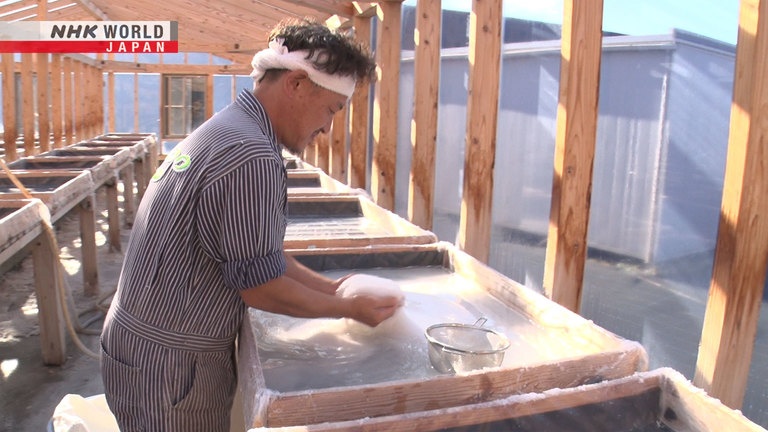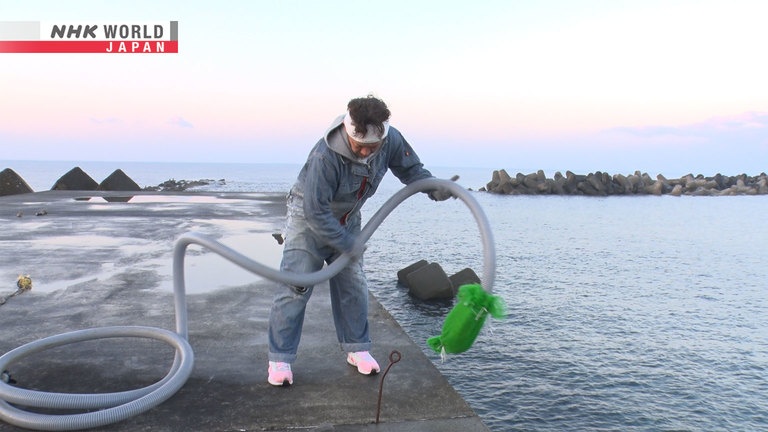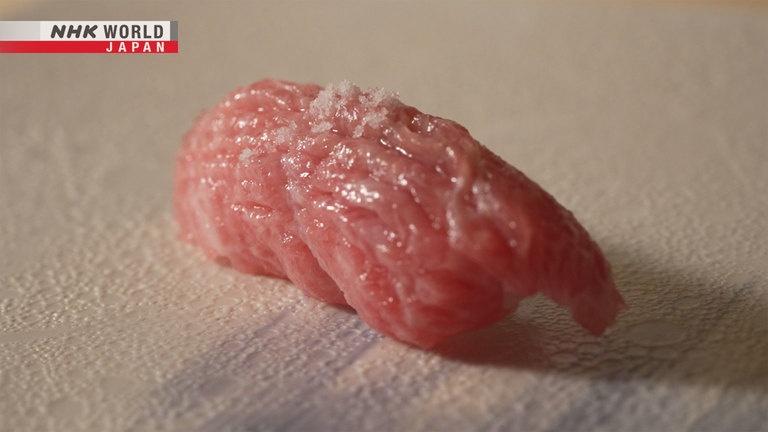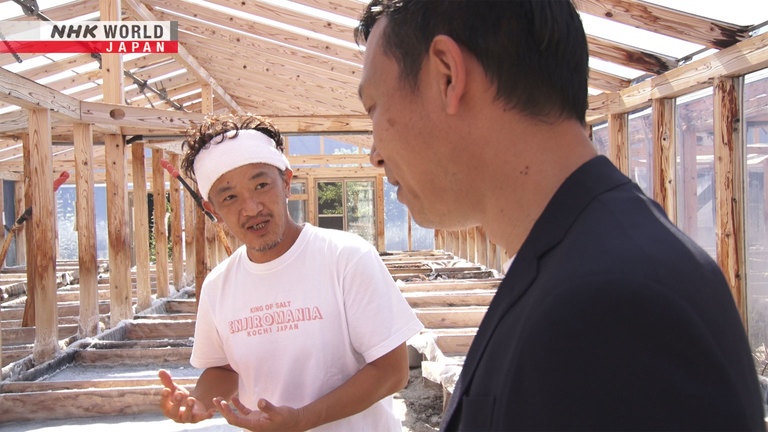Master Salt Maker - Sato Kyojiro
Meet salt maker Sato Kyojiro, whose unique, naturally produced, labor-intensive creations have earned fans among Japan's leading chefs.




Transcript
FRONTRUNNERS
His salt's unique. It's his life.
It's the most complementary seasoning, but also the most overpowering.
This is how to ensure the right flavor.
I believe my salt's the best in Japan.
Master salt maker
Sato Kyojiro
A major department store in Nagoya, western Japan.
Since opening time,
people have been coming in droves for these little black sachets.
Each containing just 50 grams of salt.
I'd heard that it tasted great, but nowhere seems to sell it.
I can't wait for dinner tonight!
We're all sold out for today.
This hit seasoning is the work of celebrated salt maker, Sato Kyojiro.
Thank you.
I'm so grateful.
I can only make small quantities,
so each year, I'm surprised to see so much demand.
But what makes his salt so popular?
Spring tide on the day of a full moon.
Sato loads up his motorized cart and heads down to the shore.
For 15 years, he's been producing salt here in Tano, Kochi Prefecture.
Honing his craft in the waters of the Pacific Ocean.
There's something mysterious about the sea at a full moon.
All sorts of activity in the water, fish spawning and so on.
All these time-honored, mystical rhythms.
So, full moon seems like the best time. It's unique.
Also key to his salt's great taste are these estuary waters,
where river and sea come together.
It's all the minerals flowing down from the hills.
That's the right water for the tastiest salt.
The bulk of Sato's work takes place in these hothouses close to the shore.
Evaporation concentrates the brine.
Then I add more water and repeat that over and over.
He uses the sun's heat to refine down the brine in these wooden trays.
Mid-summer temperatures in here can exceed 60 degrees Celsius.
But Sato spends his days inside,
stirring each of the 200 trays by hand at one to two hourly intervals.
It's about consistency.
If I leave them, concentration will vary.
And, you end up with different results.
So I keep the right concentration for even evaporation across the board.
Three months into the process...
And the consistently stirred trays are filled with salt crystals.
These are almost ready to be harvested.
There's an optimal ratio of salt to water.
Above that, the flavor goes downhill.
That figure's around 27% salt, so that's what I aim for.
I could leave things longer and double my harvest, around 30% or so.
But when you do that it starts to taste bitter.
So, I just take the good part and lose the rest.
Once dried, the salt is ready.
Producers who rely solely on the sun's heat
and manual labor are a true rarity.
But Sato Kyojiro's product is held in high regard
by top chefs around the world.
Like Nishioka Tatsumi,
a Tokyo-based sushi chef with 35 years of experience.
Since first discovering Sato's salt eight years ago,
he's sworn by its power to bring out the best in his sushi toppings.
There's just no comparison.
Initially, there's a sweetness.
Very gentle on the tongue.
It tastes natural with a really pleasant aftertaste.
Goes well with everything, from white fish to eel.
It's my pride and joy, not that I made it.
Japan's heritage of sea salt production goes back a long way.
For centuries, seawater was drawn onto banked sand terraces,
to evaporate under the sun and sea breeze.
Before the resulting residue was boiled down
with more seawater in special vats.
Even today, industrial-scale salt production
depends largely on these same principles.
But Sato's unique approach eschews boiling
to rely solely on the sun for evaporation.
His journey began with an apprenticeship under a local master...
These are the tools he used.
...learning many core concepts he still utilizes today.
I try not to lose sight of those roots.
That's why I still use the same gear,
buying the same tools over and over.
When I first joined him, he had me lick the crystals to try them.
I was shocked. I'd thought all salt was the same,
so that first taste was amazing, like "this really is something else."
I thought it must be the best salt in Japan.
And I set myself the goal of achieving something similar.
Sato's apprenticeship was served here in nearby Kuroshio.
Home since the 80s to a solar salt making cottage industry.
- Hey there. Long time no see!
- Hello, stranger!
- Everything just as it was.
- It hasn't changed at all.
Seventeen years ago,
Sato came here to learn the salt maker's trade under veteran, Yoshida Takeshi.
But it's now a decade since his much-loved mentor passed away.
Yoshida, too, saw his novel approach
to the salter's craft attract regular media interest.
His method ran seawater across fabric-draped frames
to promote evaporation by the sun and the wind,
before further reducing the concentrated brine runoff via the sun's heat.
Widow Kazumi still remembers Sato's first day.
You had piercings, blond hair, and shorts.
I thought "He's not here to make salt, surely?"
I asked what you were doing here, didn't I?
I'd read about this place and it seemed like the best place to learn.
Then aged 35, Sato had been running his own surf shop.
But, having reached a dead end,
he was in search of a new career that would keep him close to the sea.
I was 35, and I figured that if people work to the age of 70 or so,
then I was already halfway through.
More than just surfing, I wanted a bigger goal,
so I started to look for a new vocation.
He was such a hard worker.
One thing I remember is how he was always collecting data all around the place.
I never knew what, but he was always writing something.
I thought he seemed very committed.
Sato was so engrossed in the salter's craft
that he sometimes forgot to sleep or eat.
I practically lived in the hothouse, with a sleeping bag to use at night.
I wanted to live side by side with the salt,
to see how it smelled and sounded at night.
I guess most people wouldn't see the value in doing that.
They'd think what a waste of time,
but it was about reprogramming myself.
And as I stuck with those routines I gained an intuitive understanding.
After a two-year apprenticeship,
Sato was ready to go it alone
and develop his own pioneering approach to salt making.
And as time passed, he moved away from the frames used at Yoshida's saltery.
The sea breeze does help evaporation,
but I started to feel it might also introduce dust and grit to the process.
And in my quest to create Japan's best-tasting salt,
I began to reject that.
Along the way, he learned how to promote different types of crystal formation.
I compiled this kit for my sales pitch.
I can make really fine grains like these, or big ones like this,
or even clump them together like so.
While typical salt crystals are cubic,
adjusting conditions can give rise to all sorts of different shapes and sizes.
If you want smaller crystals, you slow down their growth by stirring them.
Let them alone, and they grow.
The hardest thing is fine, uniform grains.
Something like these.
I doubt anyone else can do it.
Perhaps mechanically, but not by hand.
We join Sato on a visit to Tokyo.
He's here for an event to promote resettlement to Kochi Prefecture.
Good morning! Right at the back!
Thanks for coming.
I'm here all day to speak to anyone who's interested in salt making,
tell them what it's like in the boondocks,
how much it costs to get started, everything, good and bad.
To try and combat local depopulation,
Sato has teamed up with the Tano authorities
to create a three-year apprentice program.
So you want to make salt, huh?
She has expressed an interest.
It's fun.
I want to make something in a job where I get to move around.
The good thing about salt making is the chance to push yourself higher.
Right now, I have seven apprentices.
Do they get to chill out on days off?
No, no days off.
None at all? Not even one day a week?
None at all, year round.
Salt has a life of its own, and even two hours of neglect can ruin it.
It's like when a child is crying and you pat their head to calm them,
more like "salt rearing" than "salt making" is what I always say.
Nope, no days off.
I don't know the first thing about salt,
but I am interested in learning a craft and making something,
so I'd definitely like to give it a try.
We traveled to meet two young graduates of Sato's apprentice program.
Husband and wife duo Kosaka Hideaki and Chisato
relocated here from near Tokyo,
drawn by the discovery of Sato's salt
to leave behind stable jobs in the civil service and learn under him.
We were drawn to the expertise and the focus this craft requires,
and to the lack of compromise.
We were blown away by the taste of fresh salt,
and felt like this was our calling.
Another avid user of Sato's salt is found in Hiroshima.
At an establishment
that has earned a place in one of France's best known restaurant guides.
Nakado Seiji is a chef
who puts a unique, innovative spin on traditional French cuisine.
Today's main dish is beef seasoned only with salt.
It's an approach made possible by Sato's work.
The idea is to enjoy it as it is, without any sauce.
Wow. This is a first for me!
It's not sharp like regular salt, and it really complements the fat.
Lovely and mellow.
This beef has a real umami to it,
but your typical salt would overpower that.
I wanted a salt that could showcase the meat's potential.
I invited Sato-san here to try it out and discuss the right fit,
and he developed this special salt especially for me.
- Hi there, thanks for coming.
- Sorry it took me so long.
Today marks Nakado's first-ever visit to the saltery.
He's here to check out Sato's latest innovation in salt making.
Steeping various ingredients in saltwater
to infuse the end product with complimentary notes,
attracting commissions from chefs all over Japan.
Sardines. Dried, de-headed and gutted.
I'm just extracting the juices.
That essence is why the salt looks brown.
Next, we'll add some more saltwater,
and when these crystals dissolve,
we'll extract the sardines and add another batch.
It's a process of repetition.
And here's some straw.
Straw?
Just adding some straw notes.
But what'll it be used for?
It's a salt for vanilla ice cream.
I got a request for a salt made with cattle feed.
And this is what dairy cows eat, so I knew it would be a good fit.
I see.
These are moray eel bones,
drying in the sun to soften their flavor
before they go in to their own tray of salt.
Every ingredient demands a novel approach
to showcase its own distinctive flavor.
It's fun. More fun than regular salt.
With every new ingredient I'm sent, I have to figure it out as I go along.
I can't afford to mess up, and I like those sorts of tasks.
Wow. The world's full of new ideas, huh? Amazing.
And having seen Sato's setup in person,
Nakado comes up with a novel idea of his own.
How about salt made with leaf litter?
I love woodland aromas.
One of my regular suppliers composts leaves from the nearby hills
to grow baby leaf salad.
So I think salt with the same approach might be a natural fit.
I kept stag beetles as a kid, so I think I know the smell.
Thanks again for coming!
Back in Hiroshima, Nakado drops in on his supplier.
My dishes would be nothing without his produce.
These micro leaves are a staple of Nakado's salads.
All grown with leaf litter collected from the producer's own property.
And that's what Nakado is here to discuss.
- Right here?
- This spot looks good.
I guess each spot is different, with different leaves, huh?
Ah, that's it. Now we're talking.
Like cinnamon or cloves. These earthy, spicy notes.
I wonder if Sato-san will like this?
A few days later, this strange new ingredient arrives with Sato.
Yup, leaf litter. Reminds me of beetles.
I wonder what's lurking in here.
Thanks for the parcel.
It's quite something. I'm wondering what to do with it.
It should go well with his greens, like truffle salt.
That gentle aroma is what I'm after.
I've used some pretty weird things but this is a first.
If it works out, we'll get some leafy, woody notes.
The challenge is how to soften the earthiness.
I've got a real job on my hands.
I'm kind of scared.
I feel like I should disinfect them.
But that would mess things up.
Now what's that smell...?
First he decides to wash off the soil, and boil the leaves left behind.
Maybe 100 degrees for just under ten minutes.
I don't want to cook away the essence, though.
Boiling the leaves softens the flavor,
as well as eliminating micro-organisms.
Next, he lays them out in the hothouse to dry.
This is to aid the transfer of aroma once the seawater is added.
And once they're dry, the next step can begin.
Kind of brittle now that they're dry.
After two weeks in seawater, the leaves have broken down further.
They've turned the water pretty brown, like they've dissolved.
The salt is really going to soak up this chocolate-y color.
After three months of work on the leaf-litter salt,
Sato takes the finished prototype to Nakado.
Hey there! This place looks great.
Without further ado, here's the salt you ordered.
- Let's take a look!
- I'm pretty happy with it.
- Wow, kind of heavy.
- One and a half kilos.
A nice, earthy color.
The world's first salt made with leaf litter and seawater.
Ah, yes. Let's give it a try.
On its own, it just tastes like salt.
Yeah, pretty much.
But heating it or sprinkling it on something will bring out the aroma.
It might work well in a soup.
It does have a certain umami.
It's mellow. The finish is mellow.
A kind of mineral quality. This is good.
- Really?
- Yes, really good.
Come on.
First, they try it with the same grower's micro leaves.
That's good.
Really brings out the flavor of the greens.
We could serve this as is.
And Sato reveals another hidden detail.
Smell that?
Ah, that woodland aroma.
Minute leaf fragments mixed in with the salt release their aroma when heated.
That's how it smelled in my hothouse.
These are the kind of cinnamon notes of the freshly dug litter.
Remember me banging on about cinnamon? And cloves?
This would be a good match for foie gras.
How shall I use it?
It'll work with anything so I can't decide.
My diners are going to love it.
Next, they compare oysters boiled with the leaf litter salt
and commercial salt.
First, the regular salt.
That typical oyster taste.
In a good way, I mean, that typical punchy saltiness.
Now for the leaf litter salt.
Not salty at all.
Really showcases the flavor.
It's like truffle salt.
That kind of hidden power.
Doesn't taste great on its own, but enhances whatever you pair it with.
This has something similar, I think.
The salt's role is to showcase other flavors.
I always keep that in my mind as I'm working.
I'm happy to see I wasn't wrong.
So what is it that continues to motivate Sato Kyojiro
as a "frontrunner" in his field?
Salt has so many untapped possibilities.
This leaf litter salt is a case in point,
and I want to keep taking on new challenges,
new requests that I haven't encountered before.
If people want to learn about salt,
I can teach them, and it will be great if they can make a career of it.
In the future, I would love to see more and more people
making original new salts like this.